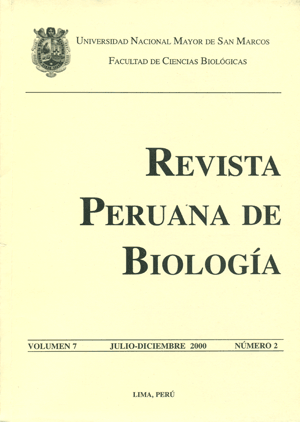Eficacy of Bacillus sphaericus 2362 in the control larvae of Anopheles seudopunctipennis (Theobald, 1901) and Culex quinquefasciatus (Say, 1823) in laboratory bioassays
DOI:
https://doi.org/10.15381/rpb.v7i2.6825Keywords:
Bacillus sphaericus, Anopheles pseudopunctipennis, Culex quinquefasciatus, biological control, larvicide.Abstract
Bacillus sphaericus 2362 liquid formulation, activity against Anopheles pseudopunctipennis and Culex quinquefasciatus larvae was tested in laboratory bioassays. Breeding place water and distilled water were used with concentrations of 1 x 10 11, 1,5 x 10 11, 2,5 x 10 11, 3,9 x 10 11 spores/mL. Target population was kept in laboratory conditions by using breeding native water and flora. One mL doses were added into test cups containing 25 II and III stage larvae and 150 mL of breeding water or distilled respectively; cups tests with the same amount of water and larvae were used as controls for each concentration, water type and larval specie tested. Testing was made three times for each concentration in laboratory conditions. Twelve replicas were made and divided in six for each species, using a total of 4800 larvae for species. Reading of larvae mortality were at 12, 24, 48, and 72 hours after addition of Bacillus sphaericus. It'was observed the high susceptibility of Culex quinquetasciatus to Bacillus sphaeficus 2362, with an overall mortality > 90% as compared with treated and controls (p-value = 0,031 and 0,012 for each type of water respectively) at 48 hours and with a concentration of 1,5 x 1011 spores/mL. It was widely demonstrated that Anopheles pseudopunctipennis is not susceptible to Bacillus sphaericus 2362 in laboratory bioassays and no significant differences were found in treatments with different types of water (p-value > 0,05).Downloads
Downloads
Published
Issue
Section
License
Copyright (c) 2000 Diana Nongrados, Julia Castro, Carlos Mariños, Alberto Laguna, Roxana Ríos

This work is licensed under a Creative Commons Attribution-NonCommercial-ShareAlike 4.0 International License.
AUTHORS RETAIN THEIR RIGHTS:
a. Authors retain their trade mark rights and patent, and also on any process or procedure described in the article.
b. Authors retain their right to share, copy, distribute, perform and publicly communicate their article (eg, to place their article in an institutional repository or publish it in a book), with an acknowledgment of its initial publication in the Revista Peruana de Biologia.
c. Authors retain theirs right to make a subsequent publication of their work, to use the article or any part thereof (eg a compilation of his papers, lecture notes, thesis, or a book), always indicating its initial publication in the Revista Peruana de Biologia (the originator of the work, journal, volume, number and date).


















